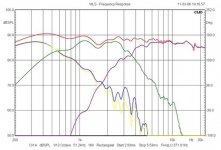Just read the reviews linked in the first post of my thread. I did not want a 'head in vice' experience either.
But I wouldn't have been able to get where I am without including the room as part of it all.
But I wouldn't have been able to get where I am without including the room as part of it all.
^ I think that's generally true, the room is no small consideration. But few people have the luxury of optimizing the room for the sound system. Even fewer have the where-with-all to build a room around the sound system as I have done. So we at least need to be clear on where along this continuum each of our situations lie.
Member
Joined 2009
Paid Member
If we quest after understanding then a well controlled room makes sense. If instead we hope to encourage DIY audio we need to cater to difficult and varied listening spaces. I find the latter to be the more rewarding and is supported by the former providing it gets pulled back into the real world.
As an user of minidsp I do understand the practicality of preset different xo slopes. The procedure is to first equalize each drivers acoustic response, then set xo and then set delays. Advanced users can also manipulate biquad values to get even more variability. One must also study radiation patterns and distortion to maintain reasonable power response/DI smoothness and distortion levels.
The charming thing is that you can do these modifications even while playing music! You instantly hear what you deliver. I do this with measuring gear attached, switching from sweeps to music.
But then again a dsp unit doesn't change the radiation pattern of a driver in a baffle/box.
The charming thing is that you can do these modifications even while playing music! You instantly hear what you deliver. I do this with measuring gear attached, switching from sweeps to music.
But then again a dsp unit doesn't change the radiation pattern of a driver in a baffle/box.
Last edited:
On the bessel, I am using 4th order bessel (accoustic) slopes on both the passive network on my MTM's and on the active network between the MTM's and my stereo subs. In the case of the MTM's I have 1st order electrical + notch filter on the M's to get that 4th order slope, and 3rd order electrical on the tweeters. The active I think from memory is third order electrical (but custom transfer function) on both to get the desired 4th order bessel accoustic slope.
I went with bessel originally because of the theoretical time domain advantages, and also because virtually no one else seems to (I like to tread the path less trodden). I think people tend to shy away from them because they don't sum completely flat like a LR.
Interestingly for whatever reason, I always find in simulation it is easier to get the drivers to match the bessel slope than a L/R one.
One interesting thing about the 2nd order bessel is that it is actually a steeper slope than a 2nd order L/R whereas with the 4th Order it is the opposite (ie L/R is steeper than bessel). So if you are worried about power handling with a 2nd order slope, a bessel may help somewhat.
I tried to do 2nd order bessel originally with my MTM's but was never happy with the sound. They were what Lynn Olson calls "Little Girl and a guitar speakers" when I changed to 4th order bessel the difference was chalk and cheese (with the 4th order being much better).
I suspect that the reason a lot of people prefer 4th order, is simply because it is much easier to get something good sounding with a 4th order filter!
Tony.
I went with bessel originally because of the theoretical time domain advantages, and also because virtually no one else seems to (I like to tread the path less trodden). I think people tend to shy away from them because they don't sum completely flat like a LR.
Interestingly for whatever reason, I always find in simulation it is easier to get the drivers to match the bessel slope than a L/R one.
One interesting thing about the 2nd order bessel is that it is actually a steeper slope than a 2nd order L/R whereas with the 4th Order it is the opposite (ie L/R is steeper than bessel). So if you are worried about power handling with a 2nd order slope, a bessel may help somewhat.
I tried to do 2nd order bessel originally with my MTM's but was never happy with the sound. They were what Lynn Olson calls "Little Girl and a guitar speakers" when I changed to 4th order bessel the difference was chalk and cheese (with the 4th order being much better).
I suspect that the reason a lot of people prefer 4th order, is simply because it is much easier to get something good sounding with a 4th order filter!
Tony.
Last edited:
Duntech provides a very elegant 'Classic Series' manual with the Opal that introduces the reader to the basic Duntech philosophies, including the use of aligned path-lengths between individual drivers and the listening position (phase coherence), symmetrical radiation patterns, simulated point-source radiation, the use of first-order crossover networks with air-cored inductors and polypropylene capacitors, and minimisation of diffraction absorption by the use of sound-absorption materials on the front baffle.
Dan.
The context of which i spoke.
dave
Well then you either don't understand what I'm saying or are simply trying to make something out of nothing (typical of you) and are bordering on trolling.
Without elaborating on what you specifically take issue with we're just going to go round in circles.
Planet10, aka Dave is just one of my multiway forum's favourites. Nobody dislikes multiway like Dave does. But he keeps at it. And I respect a lot of his ideas. 😀
Let's be honest. Most of us oldies had a good time with Robert's Radios back in the day which just used a single 6"x4" elliptical loudspeaker with some goodish electronics.
I have no truck with theories of the Universe which propose 24 dimensions. A ludicrous concept: Not Even Wrong: The Failure of String Theory and the Continuing Challenge to Unify the Laws of Physics: Amazon.co.uk: Peter Woit: 9780224076050: Books
As it goes, Shallow Bessel Filters are another sort of fools' gold. They need to be huge and complex to approach an ideal of phase linearity. You might get away with Bessel on 5" woofers with no bass and little loudness. In your bedroom. And the 5" MTM below is a nice idea, IMO. 🙂
If I was designing my dream speaker from scratch, again, I'd probably go three way on second order LR2 slopes. Like Troels Gravesen's original freebie SEAS 3-way classic with 8" bass, 4" mid and 1" tweet, which seems to have disappeared from the repertoire. But don't worry, I have it documented and stored on my drive! And below. Some question whether he used the RNX or RNY. I think it was the CA22RNX.
Two ways are actually HARD, IMO. Such compromises.
For anyone who hasn't ever heard a good three way, they just initially sound dull. It's actually because nothing stands out. It's just music. I really don't know if stepped baffle is such a big deal.
Let's be honest. Most of us oldies had a good time with Robert's Radios back in the day which just used a single 6"x4" elliptical loudspeaker with some goodish electronics.
I have no truck with theories of the Universe which propose 24 dimensions. A ludicrous concept: Not Even Wrong: The Failure of String Theory and the Continuing Challenge to Unify the Laws of Physics: Amazon.co.uk: Peter Woit: 9780224076050: Books
As it goes, Shallow Bessel Filters are another sort of fools' gold. They need to be huge and complex to approach an ideal of phase linearity. You might get away with Bessel on 5" woofers with no bass and little loudness. In your bedroom. And the 5" MTM below is a nice idea, IMO. 🙂
If I was designing my dream speaker from scratch, again, I'd probably go three way on second order LR2 slopes. Like Troels Gravesen's original freebie SEAS 3-way classic with 8" bass, 4" mid and 1" tweet, which seems to have disappeared from the repertoire. But don't worry, I have it documented and stored on my drive! And below. Some question whether he used the RNX or RNY. I think it was the CA22RNX.
Two ways are actually HARD, IMO. Such compromises.
For anyone who hasn't ever heard a good three way, they just initially sound dull. It's actually because nothing stands out. It's just music. I really don't know if stepped baffle is such a big deal.
Attachments
For anyone who hasn't ever heard a good three way, they just initially sound dull. It's actually because nothing stands out. It's just music.
For me any good speaker should do this (mine do.) Anything that is immediately noticeable is a flaw. If after an hour you still don't notice anything then you have a good speaker.
This is from educated and experienced listening experience, and usually correct.For me any good speaker should do this (mine do.) Anything that is immediately noticeable is a flaw. If after an hour you still don't notice anything then you have a good speaker.
However a speaker that passes the 'hour test' may still not pass the 'week/month/kitchen' test, and this can be according to the skill/experince level of the listener/reviewer.
Wrong is wrong and right is right, pretty much any listener will say which is which and pretty quickly.
Dan.
This is from educated and experienced listening experience, and usually correct.
However a speaker that passes the 'hour test' may still not pass the 'week/month/kitchen' test, and this can be according to the skill/experince level of the listener/reviewer.
Wrong is wrong and right is right, pretty much any listener will say which is which and pretty quickly.
Dan.
If you can' tell if a pair of speakers is good after a week, then may be you don't know what you're listening to either that or you have lots of times on your hands for wasting. Maybe you should just buy a cheap pair of speakers from Fry's electronics not bother with the sound.
This is from educated and experienced listening experience, and usually correct.
However a speaker that passes the 'hour test' may still not pass the 'week/month/kitchen' test, and this can be according to the skill/experince level of the listener/reviewer.
Wrong is wrong and right is right, pretty much any listener will say which is which and pretty quickly.
Dan.
Yes, the more you listen the better you can resolve ever smaller issues, so more is better. (I just picked an hour for convenience.) But:
"Wrong is wrong and right is right, pretty much any listener will say which is which and pretty quickly."
is not consistent with my view. If a speaker is really bad then sure one can detect this quickly, but the more minor its flaws the longer it will take to raise its ugly head. I have found some flaws only after weeks. "Wrong is wrong and right is right" does not take into account the fact that there is a continuum between the two and issues cannot be determined so easily. Good sound quality is not a black and white issue. Subtle grays can be hard to detect. Experience helps, but it is not infallible (seen that many times.)
Member
Joined 2009
Paid Member
Jeez Andy, did you get out of the wrong side of the bed? I tend to agree with Max, the real test comes from listening and of course the longer you listen the more reliable your feeling about the speaker will be. And he said 'week/month/kitchen' which in my mind means that it may take longer depending on the listener.
Jeez Andy, did you get out of the wrong side of the bed? I tend to agree with Max, the real test comes from listening and of course the longer you listen the more reliable your feeling about the speaker will be. And he said 'week/month/kitchen' which in my mind means that it may take longer depending on the listener.
If you have that much time, be my guest. I was wondering what would happen to the world if every person takes weeks/months to make a simple decision like buying a pair of speakers. After awhile, we would start talking about basic competency.
^ One should look at measurements to see the flaws and know what to listen for. I recently listened to a reputable set of speakers and looked over the design, and then did a complete set of measurements. Nothing particularly surprised me except they did measure a little worse than they sounded, but still had all the flaws that I detected in a 1 hour session using well known material. SO basically, one can save a lot of time by learning what good speakers measure like and buying from that standpoint. I'd trust good measurements far more than short casual listening.
Hopefully won't take weeks/months for measurements but then again I wouldn't be surprised given...
^ SO basically, one can save a lot of time by learning what good speakers measure like and buying from that standpoint. I'd trust good measurements far more than short casual listening.
My experience too.
I'd have to say I've come to the point of trusting properly made measurements so much, that I won't spend any time anymore trying to figure out / guess what's wrong .
Appearances can be deceptive (if you want)I seem to find more and more evidence to support my case as time goes on.

I don't know WHAT the argument here might be! 😀
Shallow filters are great, but they distort with high level, especially in two ways. Little Girl With A Guitar stuff.
Steeper filters have great control over cone-breakup and tweeter distortion when well implemented.
Here's the lowdown on Group Delay, which as any competent engineer knows is the big issue with filters. Can you hear it?
I just knocked this up in Tina TI, with a calculation by Linkwitz Lab to corroborate my results. Interestingly, and this is with time-alignment, typical group delay on 3rd and 4th order filters is almost exactly half a wavelength of the crossover frequency.
You can also see how two BW2 cascaded makes a LR4 with the pole-zero approach. 😎
We might add that reflex enclosures and bafflestep produce much bigger delays. And that there is a subtlety in the flat power response of odd order filters worth knowing about.
Shallow filters are great, but they distort with high level, especially in two ways. Little Girl With A Guitar stuff.
Steeper filters have great control over cone-breakup and tweeter distortion when well implemented.
Here's the lowdown on Group Delay, which as any competent engineer knows is the big issue with filters. Can you hear it?
I just knocked this up in Tina TI, with a calculation by Linkwitz Lab to corroborate my results. Interestingly, and this is with time-alignment, typical group delay on 3rd and 4th order filters is almost exactly half a wavelength of the crossover frequency.
You can also see how two BW2 cascaded makes a LR4 with the pole-zero approach. 😎
We might add that reflex enclosures and bafflestep produce much bigger delays. And that there is a subtlety in the flat power response of odd order filters worth knowing about.
Attachments
-
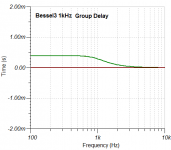 s7 Bessel3 1kHz Group Delay.PNG12.2 KB · Views: 317
s7 Bessel3 1kHz Group Delay.PNG12.2 KB · Views: 317 -
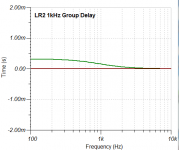 s7 LR2 1kHz Group Delay.PNG14.2 KB · Views: 309
s7 LR2 1kHz Group Delay.PNG14.2 KB · Views: 309 -
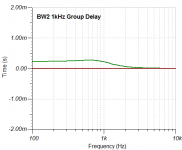 s7 BW2 1kHz Group Delay.PNG12.4 KB · Views: 511
s7 BW2 1kHz Group Delay.PNG12.4 KB · Views: 511 -
 s7 BW3 1kHz Group Delay.PNG14.1 KB · Views: 529
s7 BW3 1kHz Group Delay.PNG14.1 KB · Views: 529 -
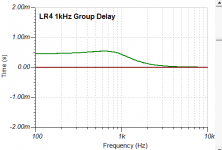 s7 LR4 1kHz Group Delay.PNG11.9 KB · Views: 523
s7 LR4 1kHz Group Delay.PNG11.9 KB · Views: 523 -
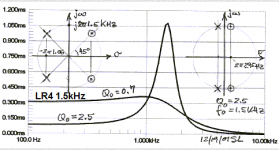 LR4 1.5kHz Group Delay Linkwitz Calculations.PNG24.5 KB · Views: 111
LR4 1.5kHz Group Delay Linkwitz Calculations.PNG24.5 KB · Views: 111
Shallow filters are great, but they distort with high level, especially in two ways.
Much less so with the choice of appropriate drivers and 200-400 Hz XO points.
dave
- Status
- Not open for further replies.
- Home
- Loudspeakers
- Multi-Way
- Well I suppose the shallow vs. steep argument will just go on and on


